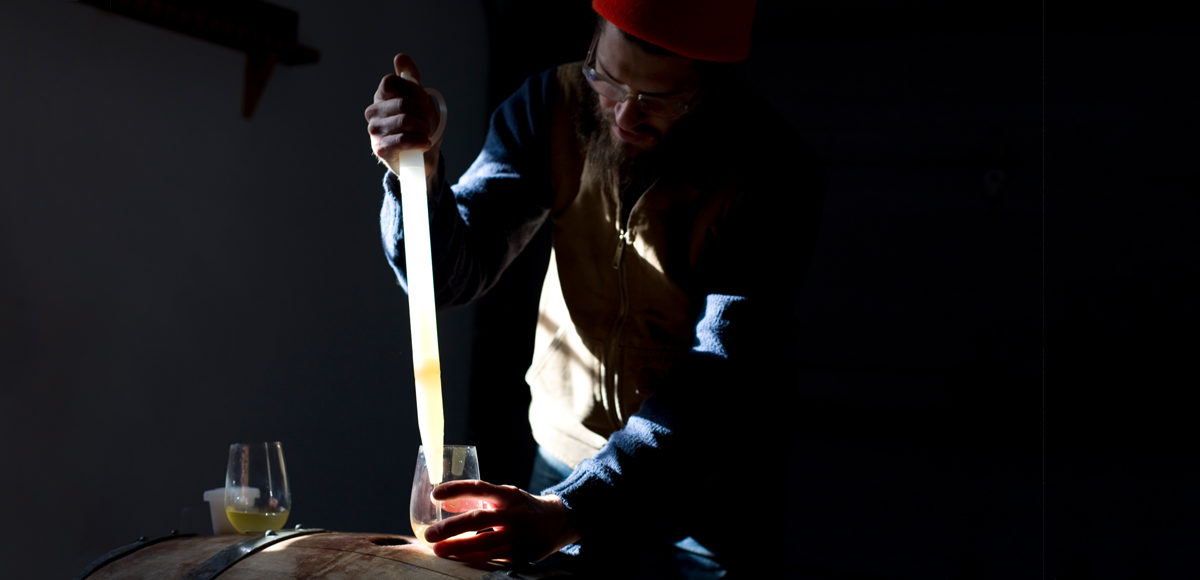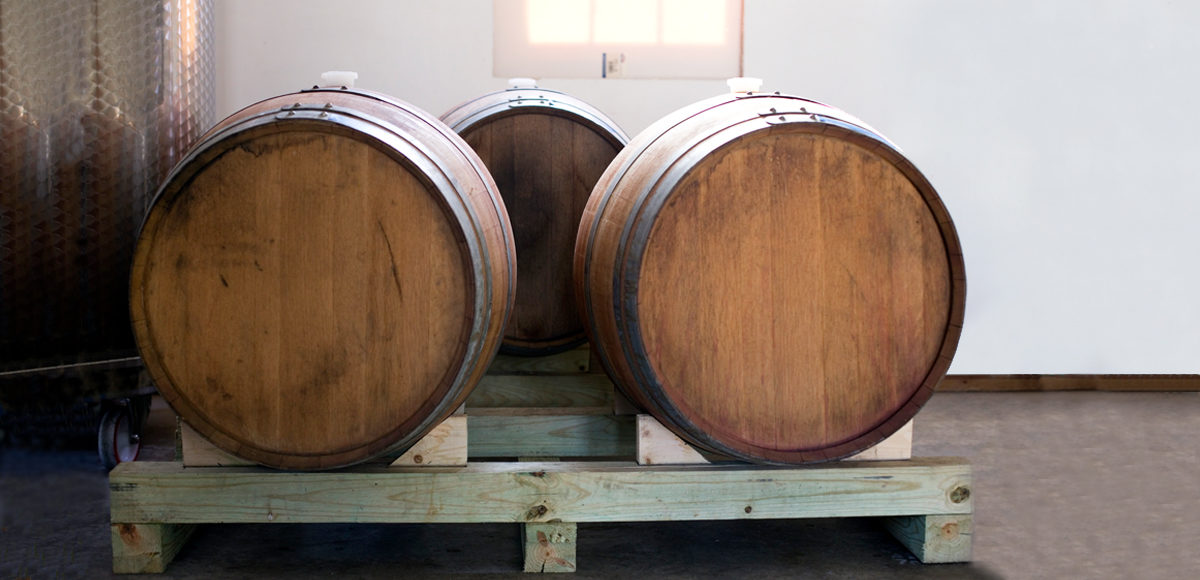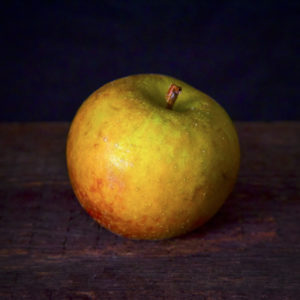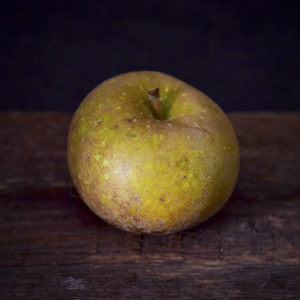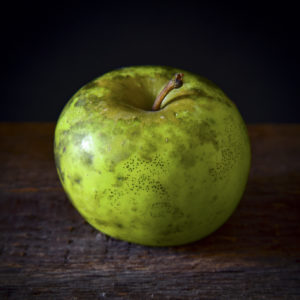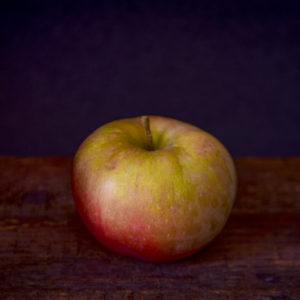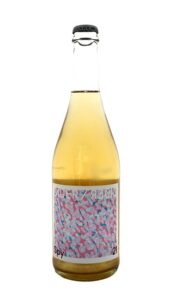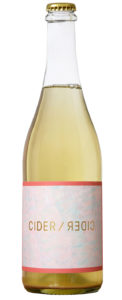Sundström Cider
Leif Sundström lives and works in New York’s Hudson Valley, helping to revive the region’s centuries-old tradition of preserving orchard fruit as cider, a drink that evokes early America’s agrarian past and, Leif believes, points the way to the region’s farming future. Leif is animated by the search for “the impacts of terroir and agriculture on cider’s ultimate potential” — and his conviction that cider from the northeastern U.S. is “poised to be among the best in the world.”
Leif makes tiny quantities of still and sparkling ciders. The fruit he uses is a blend of heirloom apples selected to express the delicate differences in variety and terroir of three historic cider-producing regions in New York. Fermentations start with a wild yeast pied du cuvée, and run long and cool to complete dryness. There is oak aging and considerable lees exposure. The sparkling ciders are traditional method without disgorgement.
The results are vinous ciders of tremendous character — textured, delicate, and nuanced, revealing of tradition, region, variety, method, and intent. Their notably high acids and greater phenolic content from maceration processes and lees contact, as well as bottling with their lees, equip them for aging and evolution in bottle.
Leif Sundström
Leif’s path to cider traces back to Ur-Schatzis Kevin Pike and Johannes Leitz. In 2002, Leif left his native Texas for Portland, Oregon and, while pursuing a passion for music there, found his place in the wine industry, including a formative period at Portland’s Boedecker Cellars. From Portland, Leif moved to New York City, to work under Kevin managing the Terry Theise portfolio of German, Austrian, and Champagne grower-producers. “I learned a vast amount about the winemaking process through direct conversations with all the growers in that portfolio,” Leif notes.
In 2013, he left New York for the Rheingau, Germany to work under Johannes. “There I began to taste simple but honest German ciders that made me aware there was incredible potential in these fruits. Working at Leitz after having worked at the winery in Oregon, I was reminded how important this type of work is to me and that this is what I truly wanted to be doing.” When Leif returned to New York, he began to explore ways to realize this vision there. Cider making was a perfect fit. He dove into an intensive study of apple growing, built community with other growers, launched a search for planted cider apple varieties and, in time, began to help plant organic cider apple orchards.
Today, Leif operates one of the country’s most forward-thinking cideries. Although he works alone, he sees himself as part of the broader northeastern U.S. cider-making collective. He aligns himself with the work of horticulturist Mike Biltonen. Biointensive orchard management — with its focus on building soil health as a key to tree and fruit vitality — is a hallmark of Biltonen’s approach and important to Leif’s thinking about the orchards and growers he works with.
Leif takes inspiration from cider makers around the northeastern U.S. who’ve “been dedicating their lives to cider for a long time.” Among them are the Finger Lakes’ Eric Shatt of Redbyrd Cider and Autumn Stoschek of Eve’s Cider, as well as Eleanor Leger of Eden Cider in Vermont. More broadly, the ciders of Bordelet, Reisetbauer, Ciderie du Vulcain, and Tom Oliver are important influences.
History
You might say cider flourished in early America precisely because wine failed. When English colonists came to America in the 17th century, some harbored hopes of having vineyards here. But vinifera vines succumbed to disease, while apple orchards thrived. Both wild and cultivated apple trees are excellently suited to the fertile soils and cool climates of the northeastern U.S. They are abundant providers and cider has long been a pragmatic method of capturing and preserving that abundance.
However, the arrival of German immigrants and their beer culture in the mid-18th century pushed cider aside. Prohibition dealt cider another blow. Then, as Leif tells it, “the New York State apple industry’s reliance on New York City as a market has meant easily farmed, shelf-ready crops have, over time, eclipsed fruit that would allow for quality cider production.” But now the scales are tipping back. A community of grower-producers are tending the historic native variety fruit trees that survive, cultivating new orchards of cider apple trees, and paying “closer attention to how they grow their fruit in accordance not only with Mother Earth, but final quality output as well.”
Orchards
“I produce cider in the Hudson Valley, but I acquire apples from a few different regions,” Leif explains. His fruit sources are in Columbia County (Hudson Valley), the Finger Lakes (between Cayuga and Seneca lakes), and Wayne County (north of the Finger Lakes — “in what some cider makers refer to as Greater Lake Ontario,” Leif adds). He plans to add Catskill Mountain area fruit soon.
The Hudson Valley is Leif’s home and focus. “It’s is a very large and diverse area, which should likely be divided when understanding apples in the context of terroir is more understood,” explains Leif. “The Hudson Valley’s terroirs provide so much potential for extremely high-quality ciders. Yet it is really only right now that producers and growers with a concern for this are beginning to access that potential. What makes this region most unique is that it is in a very encouraging moment of self-discovery and potential realization.”
Soils of the Hudson Valley are varied, but Columbia County, where Leif sources fruit, is all sandy loam. This, combined with a relatively warm microclimate, contributes dense orange oil-like and pit fruit flavors and a fuller body to the ciders. He points out that “phenolic content is significant here as well, and for many varieties the pH/acid-to-ripeness balance is supreme. Vinous-style ciders that are still very balanced are very possible here.”
“The Finger Lakes offers a contrast, with a more moderated climate, and later flowering and harvest,” notes Leif. “The same apples grown in the Finger Lakes may not have as much ripeness as the Hudson Valley in some years, but they always have a more distinctive acidity due to the overall cooler climate.” The Finger Lakes soils are largely glacial, yielding apples that give what Leif calls “a wonderful depth of flavor, very focused and high-toned, reminiscent of citrus and tropical fruits.”
“Greater Lake Ontario is a region that performs somewhere in between the other two regions in terms of ripeness and acidity. Profiles here are gentler, providing charm and balance,” Leif feels. The harsh climate is moderated by the vast lake, but of the regions Leif works, it is the last to bloom. These factors, combined with predominantly loam soils, produce rounder, softer, gentler flavors.
“My ultimate goal with Sundström Cider is to be able to source from multiple regions, and ideally be able to work with enough developing orchards that I can produce single-orchard ciders from each of those regions in an effort to document some element of terroir throughout the years, so that I have something to look back on, to become better informed about them. Sponti will likely always be a blend of the regions, while the other future bottlings aim to be very terroir specific,” explains Leif.
Fruit
Leif’s interest is in heirloom varieties, many native to the northeastern United States, and traditional cider varieties, including Golden Russet, Ashmead’s Kernel, Northern Spy, Newtown Pippin, Roxbury Russet, Wickson, Baldwin, and Rhode Island Greening. Leif also looks to apples of French or British origin that are grown specifically for cider in those countries. Leif believes the key point is that “most cider consumers are not even aware of which apple varieties they are drinking. Grape variety is almost always of decisive importance to a consumer when buying a wine, and hops variety is becoming increasingly important to consumers of craft beer. Why aren’t people asking which varieties of apples are in their ciders?”
Farming
Leif encourages more wholistic farming methods, including Integrated Pest Management, among the growers he works with. Looking ahead, Leif says, “I have helped plant several new orchards, all of which are entirely cider-focused, with variety selection, planting, and farming methods aimed at producing the best quality cider. These are in several different regions of our state and [should] begin bearing significant quantities of fruit in the next two to five years.”
“Apples are at a greater disadvantage than most fruit,” Leif explains. “They have a longer growing season and are therefore subject to more possible diseases, pests, and natural climatic pressures. The great irony is that eating apples often gather the cheapest price per pound at market, though they require the most inputs and attention in the orchard. These natural facts, coupled with the public’s expectation that the fruit be ‘perfect,’ have created a culture that has put organic orcharding in a very difficult transition — largely because there are very few incentives to convert. Organic is more than just a catch phrase, it is a true crusade.”
Cellar
The cellar work at Sundström Cider is rooted in traditional techniques and minimal intervention. Ripeness, acids, tannins, and pH determine cider style. Complexity, texture, and depth come from the cider maker’s choice of apple varieties, fermentation style, and time on the lees.
The ciders start with the “sweating” of select varieties. A portion of the fruit’s water content is allowed to evaporate at cool cellar temperature over a period of several weeks, concentrating sugars, phenolics, and acids, and also allowing the fruit to develop more complex flavors. The same varieties that are selected for sweating are then ground and macerated for up to 48 hours, depending on variety and vintage. Maceration draws more phenolics, aromatics, and flavors into the juice, and helps to stabilize it with the natural antioxidants found in the apple pomace. This also allows for positive oxidation to contribute to fixing phenolics and tannin.
Post-maceration, the must is pressed direct to tank for fermentation. All inoculations are from native yeast cultured in a pied du cuvée. (Leif’s began with a spontaneous fermentation of wild crabapples, and has been “cycled from vintage to vintage to maintain an ever-growing and evolving native yeast for three years now,” he says.) Fermentations occur without temperature control, primarily in the cool months of November and December. Ciders destined for oak aging are racked to barrel just before sugars reach zero, to allow the final phases of fermentation to occur in oak and to carry more suspended lees into the aging process. All tank-aged ciders remain on their gross lees until bottling. Aging of the ciders occurs for an average of six months before bottling.
The barrel-aged ciders are raised in neutral wine barrique. Battonage is practiced, with varying degrees of frequency, dependent on each vintage’s specific ripeness and phenolic concentration. Sulfur is used sparingly and judiciously. Depending on a cider’s pH, it may be sulfured once after alcoholic fermentation, but generally this does not occur until the ciders are racked to bottling tank and then at a minimal rate in accordance with their specific pHs.
All sparkling ciders are refermented in bottle without disgorgement. Fine lees are left in the bottle to allow the ciders to continue their evolution. “I am not as interested in clarity of the cider or a controlled consistency of the cider from bottle to bottle as much as I am interested in these ciders being the best they can be each time a bottle is opened,” explains Leif. “I do, however, recommend that consumers allow bottles to settle upright and to pour carefully to avoid as much sediment as possible.” That said, “the lees are always very fine and even when they make it into the glass, they are themselves quite pleasurable.” Cider/Cider may even be better when cloudier. Leif recommends it as “a cider to be drunk more casually and younger — so be free with it.”
